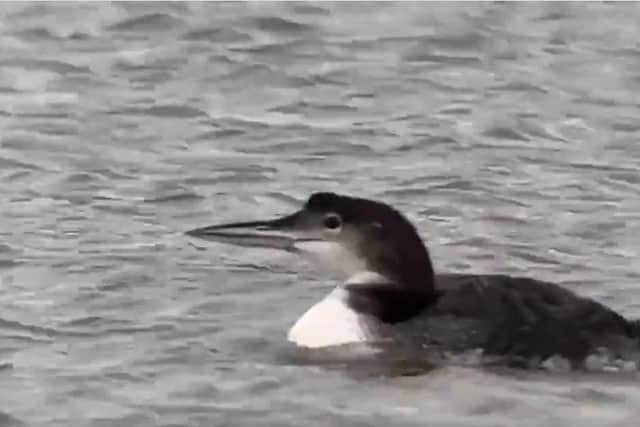Rare bird ruffles feathers at Peterborough’s Ferry Meadows after first ever sighting at the park
and live on Freeview channel 276
A Great Northern Diver was spotted in the park earlier this week - the first time one had ever been spotted in the park.
The bird is not the only unusual feathered friend who has been sighted at Ferry Meadows this year - with a Red Headed Smew, Red-throated Diver, Shag and Red-breasted Merganser all arriving.
Advertisement
Hide AdAdvertisement
Hide AdA spokesman for the Nene Park Trust said it was believed cold weather caused by Storm Darcy was a factor in the birds arriving.


Paul Bolton captured a video of the Great Northern Diver during a visit to the park.
He said; “I was walking with my children in Ferry Meadows when a friend text to say that a Great Northern Diver had apparently been seen on Gunwade lake.
“This is believed to be the first record for Ferry Meadows and the species remains very infrequent in the Peterborough area with perhaps one record a year if we’re lucky.
Advertisement
Hide AdAdvertisement
Hide Ad“So, we hurriedly made our way round to the west side of Gunwade where the bird was fishing. Very pleased to confirm the identification (adult in winter plumage) was correct bearing in mind the aforementioned status. The children were decidedly less excited!
“At the same time as I was watching the Diver, another very scarce winter visitor to the Peterborough area and even scarcer at Ferry Meadows, a Smew, flew round the inlet area before settling.
“This individual was either a female or first winter male and is commonly referred to as a ‘redhead Smew’ due to its head colour. This individual has been present for a few days and I had observed it on a walk previously.”
The Wildlife Trust said: “Great northern divers breed in Greenland, Iceland and North America, where they’re called common loons. There have been occasional records of them breeding in Scotland, but these are very rare.
Advertisement
Hide AdAdvertisement
Hide Ad“They breed on large woodland lakes or pools on tundra, with the male and female working together to build the nest on an island or shoreline. They’re excellent swimmers, using their large feet to chase after small fish under the water.
“Great northern divers usually spend the winter on the sea, favouring shallow areas close to shore. They can sometimes be seen migrating along the coast singly or in small flocks.”
A spokesman for the Nene Park Trust said: “The ‘smew’ is a scarce bird in the Park with only a handful of records in the last 30 years. Smews are small ducks that arrive in winter to the UK in small numbers from Scandinavia and Russia.
“The ‘Great Northern Diver’ sighting is the first record for the Park. There was an influx of these birds in the UK in November with inland waters producing multiple records. Rutland Water has had up to 8 and Grafham has had up to 5. Great Northern Divers are probably from Iceland or North eastern Canadian populations and winter in the North Sea.
Advertisement
Hide AdAdvertisement
Hide Ad“The recent influx to the Peterborough area, of what are normally sea birds, is attributed to storm Darcy. The cold easterly wind and snow has forced many birds across the North Sea to the UK. There have also been sightings of Red-throated Diver, Shag and Red-breasted Merganser.”
Comment Guidelines
National World encourages reader discussion on our stories. User feedback, insights and back-and-forth exchanges add a rich layer of context to reporting. Please review our Community Guidelines before commenting.